A new biomimicry marine current turbine: Study of hydrodynamic performan- ce and wake using software OpenFOAM*
2016-09-29YungJehCHU
Yung-Jeh CHU
A new biomimicry marine current turbine: Study of hydrodynamic performan- ce and wake using software OpenFOAM*
Yung-Jeh CHU
Department of Civil Engineering, Faculty of Engineering, University of Malaya, Kuala Lumpur 50603, Malaysia,E-mail: chujeh2022@gmail.com (Received March 13, 2014, Revised August 20, 2015)
Inspired by Dryobalanops aromatica seed, a new biomimicry marine current turbine is proposed. Hydrodynamic perfor- mance and wake properties are two key factors determining whether a new marine current turbine design is practical or not. Thus, a study of hydrodynamic performance and wake of the proposed biomimicry turbine is conducted. The computational fluid dynamics (CFD) software, OpenFOAM is used to generate the required results for the mentioned study. The hydrodynamic performance and wake properties of the proposed biomimicry turbine is compared to two conventional turbines of Bahaj et al. and Pinon et al. re- spectively. The simulation results showed that the proposed biomimicry marine current turbine gives optimum power output with its power coefficient,at the tip speed ratio (TSR) of 1.5. Under the same boundary conditions, the maximum torque pro- duced by the proposed biomimicry turbine at zero rotational speed is 38.71 Nm which is 1110% greater than the torque generated by the turbine of Bahaj et al.. The recovery distance for the wake of the biomimicry turbine is predicted to be 10.6% shorter than that of IFREMER-LOMC turbine. The above-mentioned results confirm the potential application of the proposed biomimicry marine curre- nt turbine in the renewable energy industry.
marine current turbine, wake, biomimicry, computational fluid dynamics (CFD), OpenFOAM
Introduction
The hydrodynamic performance and wake pro- perties are two key factors to determine whether a new marine current turbine design is applicable in indust- ries or not. The torque and thrust generated by a rota- ting marine current turbine will determine its hydrody- namic performance during operation. On the other hand, the wake property such as the wake recovery distance is important in predicting the minimum spa- cing required between turbines in array. Thus, it is a must to conduct hydrodynamic performance and wake study through recognized methods in order to prove that the new marine current turbine design is worth in- vesting. There are a few recognized methods which have been used to measure or predict the hydrodyna- mic performance and wake properties of marine curre- nt turbines, among them are experiments and numeri- cal simulations.
There were few examples of successful experi- ments conducted in measuring marine current turbine torque, thrust and wake properties such as those stu- died in Refs.[1-10]. A typical experiment consists of a model scaled turbine which immersed in a flume tank or a flow channel with supplies of inflow water in close or open circuits. Sensors are used to measure the torque and thrust on the turbine. The velocity at down- stream flow at various positions is usually measured with calibrated flow velocity measuring device such as acoustic Doppler or laser Doppler velocimeter. The experimental results of the turbine wake can be relia- ble if the scaled model of the turbine is sufficiently large. In spite of the reliable results, many researchers chose to predict the hydrodynamic performance and turbine wake properties by using numerical simulatio- ns due to various restrictions on experiments such as expensive set-up and long preparation time.
The CFD gains in popularity among researchers as a tool for turbine research as shown in Refs.[11-15]. Several CFD software such as ANSYS-FLUENT and OpenFOAM were available free or with affordable li- cense price. Due to the fast growth of technology nowadays most researchers are able to own at least a high performance workstation for research study. This enables accurate prediction of turbine wake properties to be obtained with shorter period of time compared to experimental methods. However, most of the predi- cted simulation results still need to be validated by ex- perimental results due to the errors induced by the nu- merical method itself such as truncation errors.
The objective of this study is to predict the hy- drodynamic performance and wake properties of a proposed biomimicry horizontal axis marine current turbine by using the open sourceCFD software, OpenFOAM. The predicted hydrodynamic performan- ce of the biomimicry marine current turbine is compa- red to Ref.[4] while the predicted wake properties are compared to Ref.[11]. The results from the compariso- ns will give preliminary idea on the possible applica- tions of the proposed biomimicry marine current turbi- ne in renewable energy industry.
1. Background of the proposed biomimicry marine current turbine
The idea of mimicking the Dryobalanops aroma- tica seeds in turbine design was proposed by Chu du- ring his undergraduate, when Dryobalanops aromatica seeds were found at the Geology Faculty in University of Malaya. The inspiration came when one of the Dryobalanops aromatica seed was seen rotating stably in the air during a visit to the Geology Faculty. The unique shape of the wings of Dyrobalanops aromatica seeds might suggest a solution in optimum turbine blade design. Thus, samples of Dryobalanops aromati- ca seeds were gathered, observed and photographed for study use. Figure 1 shows the snapshots of a Dryobalanops aromatica seeds found at Geology Fa- culty, University of Malaya.
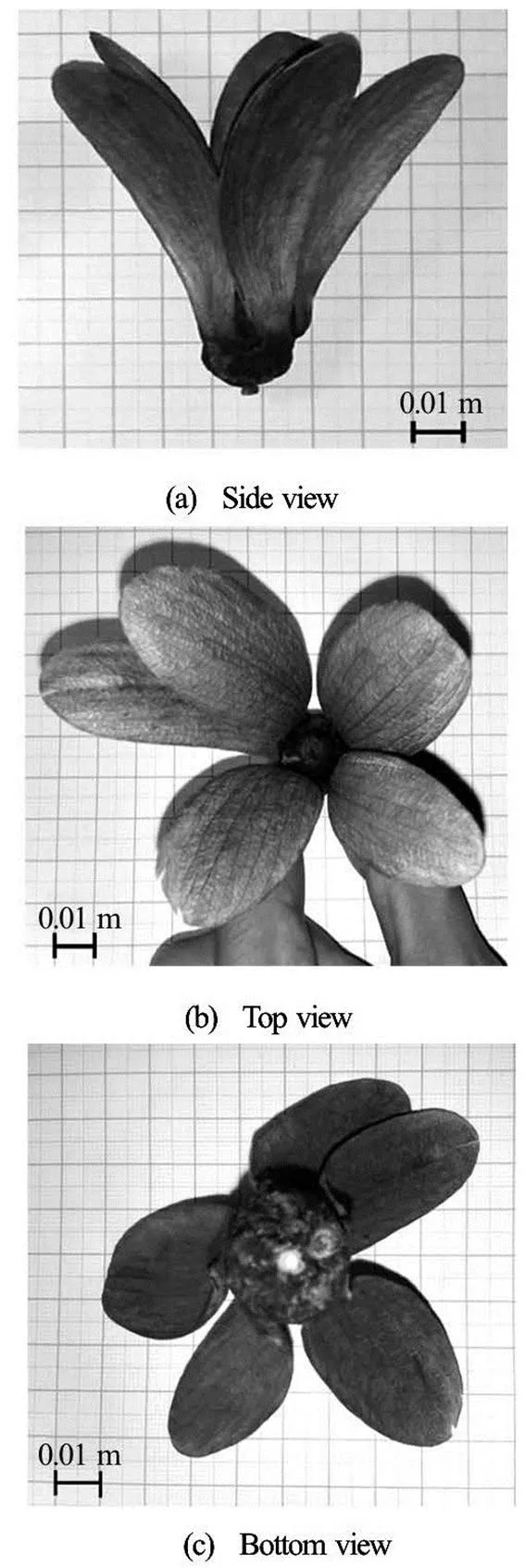
Fig.1 Snapshots of a Dryobalanops aromatica seeds found at Geology Faculty, University of Malaya (Note: Due to the near distance of photographing, the objects nearer to the camera appear to be larger. The 0.01 m grid size is only for rough estimation)
Although the Dryobalanops aromatica seed uses wind as the media of propagation, it is supposed that its physical characteristics and flight mechanism can be applied in the design of marine current turbine. Thus, the biomimicry marine current turbine is propo- sed to have turbine blades similar to the shape of the wings of Dryobalanops aromatica seed, three-bladed and a downstream type turbine where the rotor is loca- ted behind the nacelle. Figure 2 further illustrates the components of the proposed biomimicry turbine.
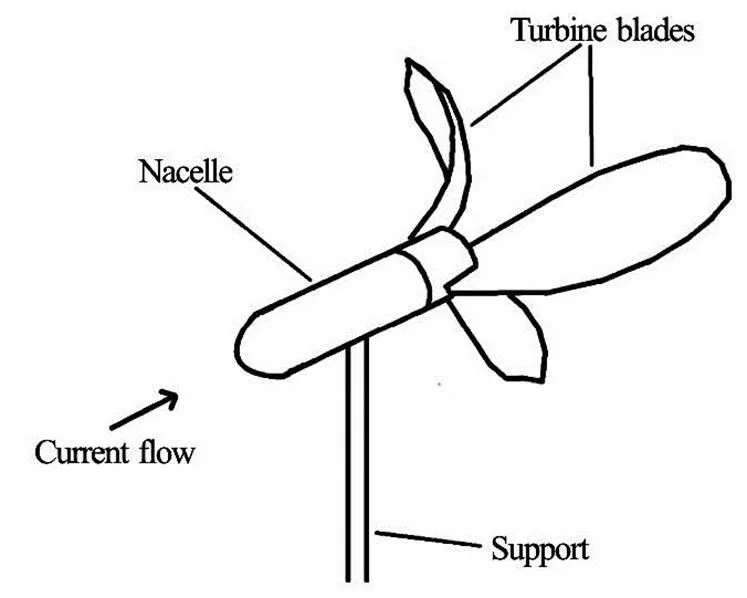
Fig.2 Sketch of the proposed 3-bladed biomimicry downstream horizontal axis turbine
2. Numerical simulations
Two sets of numerical simulations were done in terms of hydrodynamic performance and wake predi- ctions. For prediction of hydrodynamic performance, the geometrical properties of the proposed biomimicry turbine such as the number of blades, rotor size, hub size and boundary conditions were totally made the same as those of the turbine reported[4]. For wake pre- diction, all the geometrical properties of the proposed biomimicry turbine such as the number of blades, rotor size, hub size and boundary conditions were also made the same as those of the IFREMER-LOMC tur- bine from Ref.[11]. The power coefficient,was set approximately the same in wake simulation for the cases of IFREMER-LOMC and biomimicry turbine in order to check the differences of their wake properties when the power output of both turbines is roughly the same. Grid independence test was conducted to deter- mine the suitable mesh sizes for all simulation cases on account of the limiting available computational power. The numerical simulation was continued with the preferable set of mesh sizes and number of itera- tions. The discussion includes the predicted results such as the torque, thrust, velocity line plots, pressure line plots, vorticity contour, velocity contour and par- ticle streamlines.
3. Computational hardware and software
A workstation with processor Intel® Core™ i7- 4770K CPU @ 3.50 GHz×8, were used to run the si- mulations with Ubuntu 12.04 LTS as the operating system. GetData and JavaFoil were used to generate the coordinates required in turbine geometry mode- lling. GetData Graph Digitizer is a program for digiti- zing graphs and plots. JavaFoil is a relatively simple program, which uses several traditional methods for airfoil analysis. The geometry of the turbines was mo- delled by using SALOME. SALOME is an open-sou- rce software that provides a generic platform for Pre- and Post-Processing for numerical simulation. The meshing and solving process was done in OpenFOAM. OpenFOAM is a free, open source CFD software pa- ckage developed by OpenCFD Ltd at ESI Group and distributed by the OpenFOAM Foundation. ParaView was used to view the simulation results. ParaView is an open-source, multi-platform data analysis and visualization application.
3.1Bahaj et al. turbine geometry modelling
The turbine from Ref.[4] consists of three turbine blades. Its rotor diameter is 0.8 m, hub diameter is 0.1 m and the turbine blades were developed from the profile shape of a NACA 63-8xx and with chord, thi- ckness and pitch distribution presented in Table 1.
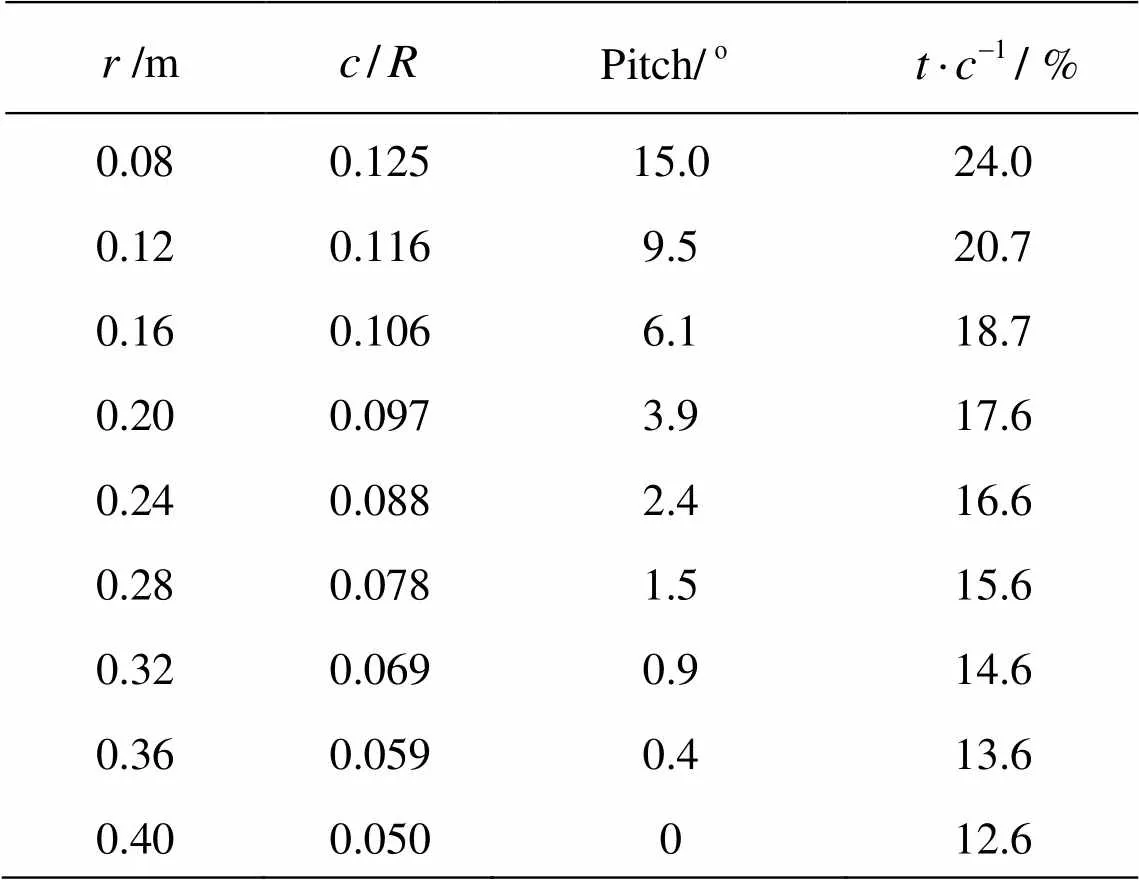
Table 1 Turbine blade section properties from Ref.[4]
The blade set angle is the angle at the tip of the blade, (i.e. the blade angles in Table 1 refer to a set angle of)[4]. The blade is designed such that maxi- mum power would be produced at aset angle[4]. Thusset angle of the turbine from Ref.[4] is used in this study as a benchmark to determine the hydro- dynamic performance of the proposed biomimicry marine current turbine. The coordinates of the turbine blade surfaces in Ref.[4] were generated by using JavaFoil according to the turbine blade section proper- ties in Table 1. The generated coordinates of the turbi- ne blade surfaces in Ref.[4] were then exported to SALOME for turbine geometry modelling. The mode- lled turbine as that of Ref.[4] is shown in Fig.3.
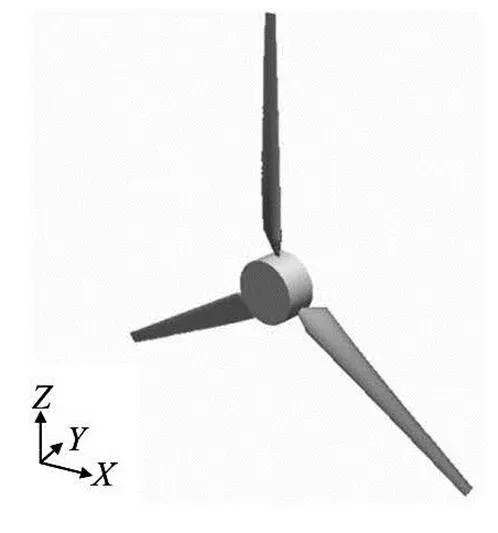
Fig.3 Conventional turbine geometry modelled according to the details available from Ref.[4]
3.2
The IFREMER-LOMC turbine geometry from Ref.[11] consists of three turbine blades, 0.700 m rotor diameter, 0.046 m hub radius and 0.720 m hub length. The turbine blades were developed from the profile shape details as shown in Table 2.
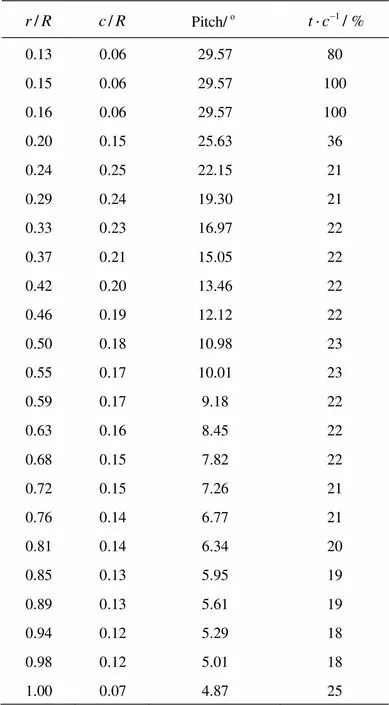
Table 2 Blade section characteristics of the IFREMER- LOMC turbine obtained from Ref.[11]
The background of the IFREMER-LOMC turbi- ne is as shown in the following quotes extracted from Ref.[11]:
“The second set of blades used for validation purposes was first designed by tidal generation limited (TGL) and experimentally tested in the IFREMER flume tank of Boulogne-sur-Mer (France). However, this set of blades, presented in Maganga et al., is pa- tented so a similar and open set of blades was develo- ped for experimental validation at IFREMER and nu- merical trial at LOMC-Le Havre University (France). In the present paper, this last open blades configura- tion will be named as the IFREMERLOMC configura- tion. The turbine blades are designed from a NACA63418 profile.”
JavaFoil and SALOME were used to produce the geometry of the IFREMER-LOMC turbine. The mo- delled geometry was then exported to OpenFOAM for simulation. Figure 4 shows the 3-D view of IFREMER-LOMC turbine geometry modelled in this study.
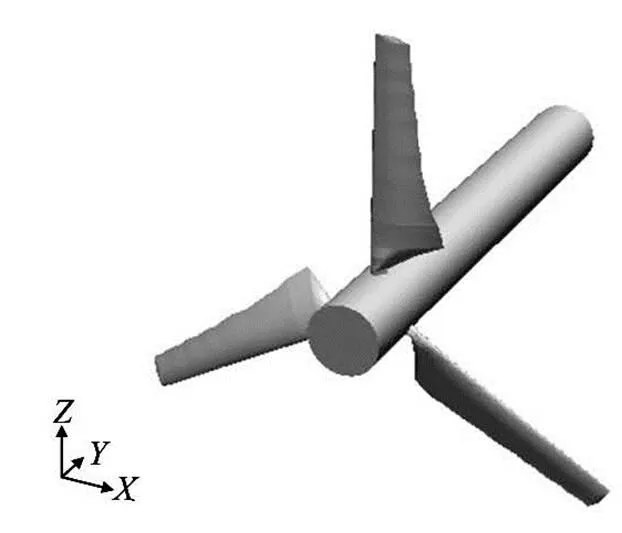
Fig.4 The modelled IFREMER-LOMC turbine geometry using SALOME
3.3
The photo of a wing of Dryobalanops aromatica seed were used to generate the required blade surface coordinates for the mentioned geometry modelling. The coordinates of the outlines of the wing of Dryobalanops aromatica seed is generated by using GetData. The generated coordinates were then expo- rted to SALOME for geometry modelling. In order to have a fair comparison with the simulation cases of Ref.[4] and IFREMER-LOMC turbine, the rotor dia- meter, hub and the number of turbine blades of the two modelled biomimicry marine current turbines were made the same as those in Refs.[4] and [11]. The key difference between the biomimicry turbine and the turbine from Refs.[4] and [11] is the shape of the turbine blades. Figure 5 shows the photos of a wing of Dryobalanops aromatica seed while Fig.6 shows the two modelled biomimicry marine current turbines for hydrodynamic performance and wake simulations.
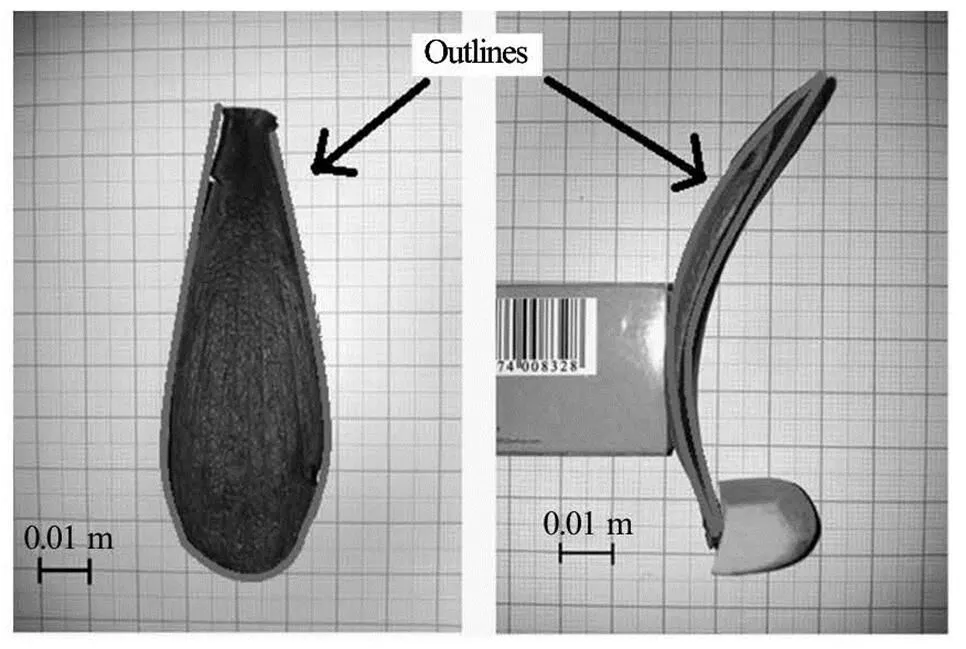
Fig.5 Photographs showing outlines (light grey) of a wing of Dryobalanops aromatica seed used in biomimicry turbine blade modelling. The left side of the photo shows conca- ve surface while the right side shows the side view of a wing of Dryobalanops aromatica seed
3.4
The definition of rake, pitch and skew angles of the biomimicry turbine blade are as shown in Fig.7. The rake angle was fixed towhile the skew and pitch of the biomimicry turbine blades were altered in order to see which combination will give optimum power output. Lower mesh numbers (each case around 250 000) were applied in this test.
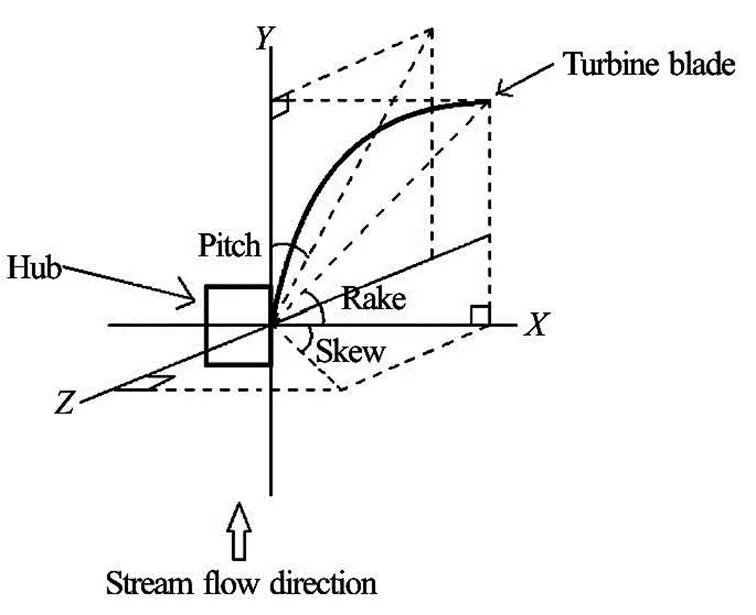
Fig.7 Definition of rake, pitch and skew angles of the proposed biomimicry turbine blade (viewed from the top of turbine) in this study
Simulation results from eight different combina- tions of pitch and skew angles of the biomimicry tur- bine blade in the optimum turbine geometry test are as shown in Fig.8 and Fig.9. From the results shown, the combinations ofpitch andskew gives the highest maximum power coefficient,which is around 3.8 among other combinations. Thus, it was decided that this combinations ofpitch andskew is to be implemented into the biomimicry turbi- ne geometry for the hydrodynamic performance com- parisons.
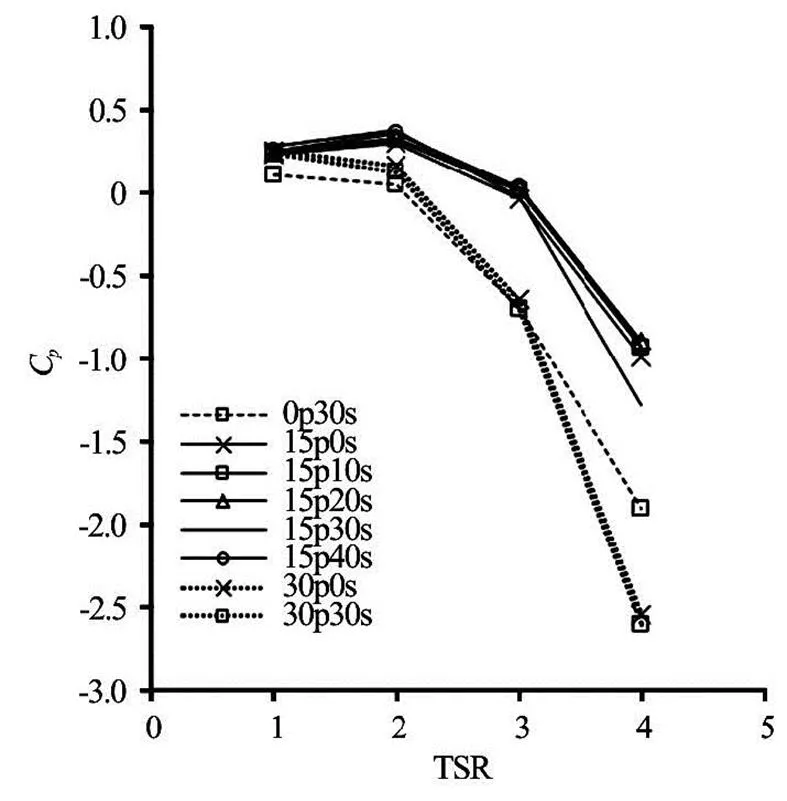
Fig.8 Power coefficient graph of the proposed biomimicry tur- bine with different combinations of turbine blades pitch and skew angles e.g., 15p30s means in pitch and in skew
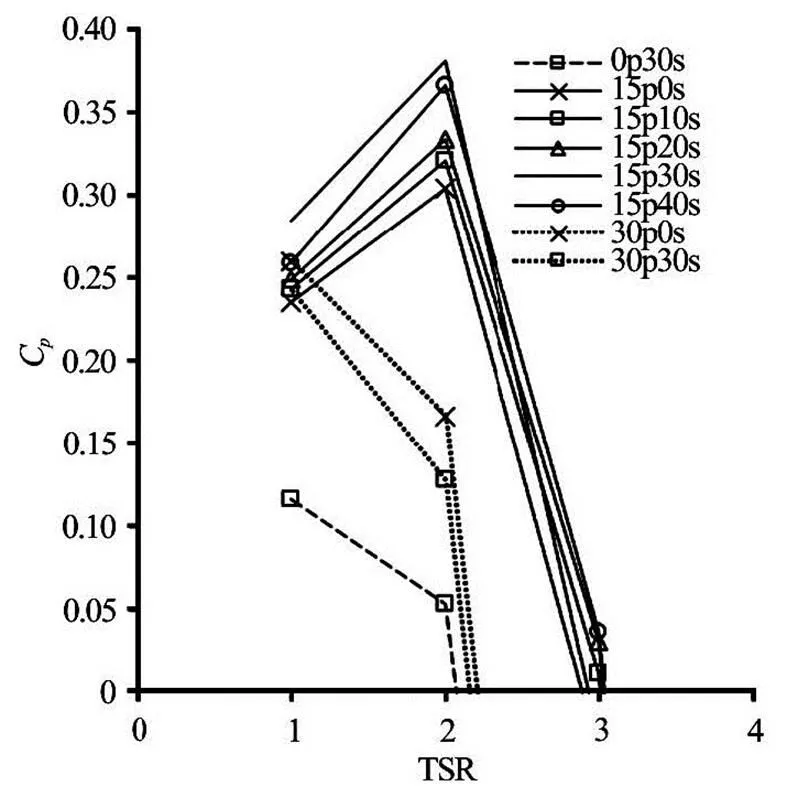
Fig.9 Power coefficient graph (zoomed in for the sake of clari- fication) of the proposed biomimicry turbine with differe- nt combinations of turbine blades pitch and skew angles e.g. 15p30s means in pitch and in skew
3.5
For the simulation of hydrodynamic performance, the free stream velocity,with initial turbulence intensitywere applied throughout the mesh domain of all the turbine of Ref.[4] and biomi- micry turbine. The rotational speed of the rotor was altered according to the specific tip speed ratio (TSR) for each simulation case. Standardwall function was applied at the turbine blades surfaces.
On the other hand, the free stream velocity,with initial turbulence intensitywere applied throughout the mesh domain of both the IFREMER-LOMC turbine and biomimicry turbine wake simulation cases. Standardwall function was also applied at the turbine blades surfaces of both simulation cases. Several trials with different rotatio- nal speed and tip speed ratio of rotor were done for both simulation cases to obtain the same predicted power coefficient,while it was not being conce- rned for the case of thrust coefficient,in this study. Through trial and errors, it was found that the opti- mum predicted power coefficient,of both the IFREMER-LOMC turbine and biomimicry turbine cases were very near, 0.37 and 0.38, respectively. Thus, the wake properties of the IFREMER-LOMC turbine and biomimicry turbine simulation cases with optimum TSR 3.67 and TSR 1.5 respectively were compared.
The predicted power coefficient,and thrust Coefficientin this study were calculated with Eqs.(1)-(3).
3.6
All the simulation cases in this study were solved by using the OpenFOAM solver named MRFSimpleFOAM. MRFSimpleFOAM is a steady- state solver for incompressible, turbulent flow of flui- ds with multiple reference frame (MRF) regions. The SSTturbulence model was adopted for the si- mulations in this study. The torque and thrust of the turbine was calculated by the tool from a post-proce- ssing library named “forces”. The “forces” post-proce- ssing library provides tools for post-processing force/ lift/drag data with function objects.
3.7
Grid independence test was conducted for the Ref.[4] and biomimicry turbine case to ensure the mesh quality is enough to achieve accurate results. Di- fferent number of cells and number of iterations were applied in the test and the results are as shown in Table 3 and Table 4.
Table 3 Grid independence test result for Ref.[4] turbine case with set angle, and Number of cellsAverage node interval sizeon blades surfaces/mNumber of iterations 262 7540.00155000.06110.2721 5 0000.06110.2722 10 0000.06110.2722 655 3620.00105000.05910.2680 5 0000.05910.2683 10 0000.05900.2684 1 304 0430.00085000.05730.2649 5 0000.05740.2658 10 0000.05750.2660
Table 4 Grid independence test result for biomimicry turbine case with rake angle , pitch angle , skew angle , and
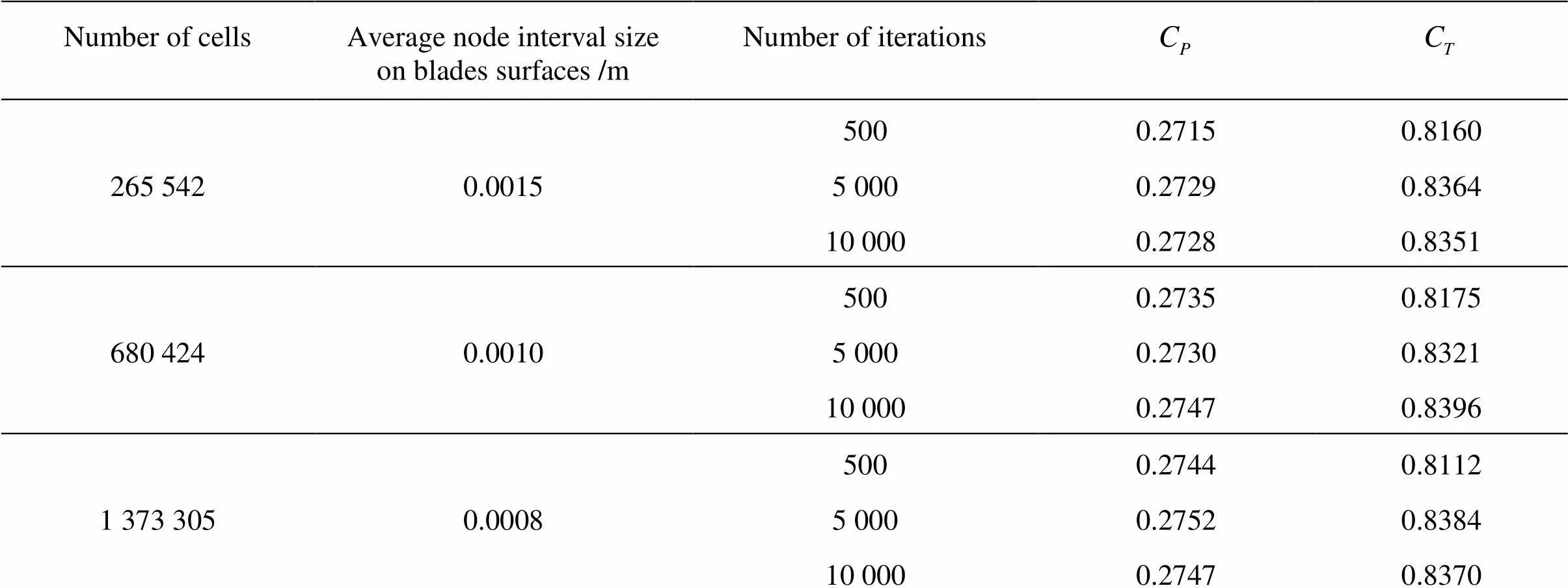
Table 3 Grid independence test result for Ref.[4] turbine case with set angle, and
Number of cellsAverage node interval sizeon blades surfaces /mNumber of iterations 265 5420.00155000.27150.8160 5 0000.27290.8364 10 0000.27280.8351 680 4240.00105000.27350.8175 5 0000.27300.8321 10 0000.27470.8396 1 373 3050.00085000.27440.8112 5 0000.27520.8384 10 0000.27470.8370
From the result of the grid independence test, theandvalues converged at 10 000 iterations and 1 304 042 mesh cells for the turbine of Ref.[4]. For the biomimicry turbine, theandvalues con- verged at 10 000 iterations and 1 373 305 mesh cells. Thus, all the hydrodynamic performance simulations were run in 10 000 iterations and the mesh with 1 304 043 cells is chosen for simulations of turbine from Ref.[4] while the mesh with 1 373 305 cells is chosen for the biomimicry turbine simulations. Figure 10 shows the mesh domain slice sections for the simu- lation cases of Ref.[4] and biomimicry turbine.
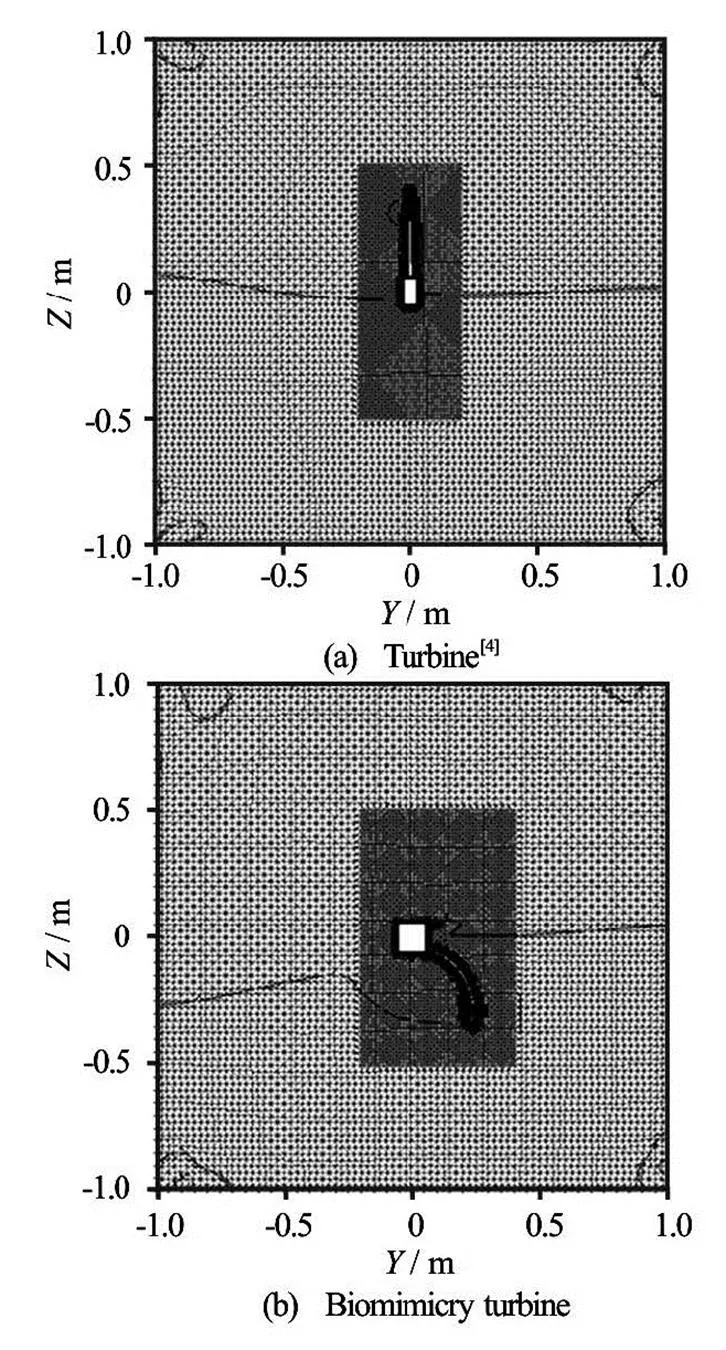
Fig.10 Mesh domain slice sections
The quantitative uncertainties for the grids were estimated using the factor of safety method and they are referred to [16-19]. The uncertainties ofandwereand(whereis per- centage of fine grid solution) of the 1 304 042 mesh cells solution for the turbine of Ref.[4] while it isandof the 1 373 305 mesh cells so- lution respectively for the biomimicry turbine.
3.8
Grid independence test was also conducted for both IFREMER-LOMC turbine from Ref.[11] and biomimicry turbine to ensure good mesh quality. Si- mulation of cases with different mesh cell numbers were run in the test and their mesh properties are as shown in Table 5.

Table 5 Mesh properties of simulation case for Biomimicry and IFREMER-LOMC turbine
The difference in mesh size and number of cells between the IFREMER-LOMC turbine and Biomimi- cry turbine were adjusted to be as small as possible to avoid different influence due to different grid size. The velocity distribution located at a distance of(0.84 m) from the origin was adopted for the test. The results from the test show that the influence of the grid sizes was of minimum when the number of cells rea- ches 3 667 938 for IFREMER-LOMC turbine while it was 3 937 105 for biomimicry turbine. The optimum number of iterations for the best results is about 10 000. The velocity distribution plots were as shown in Fig.11 while the slice sections of the mesh domains are presented in Fig.12 and Fig.13.

Fig.11 Velocity line plots at distance of from origin with different mesh numbers. Velocity line plots at distance of from origin with different number of iterations
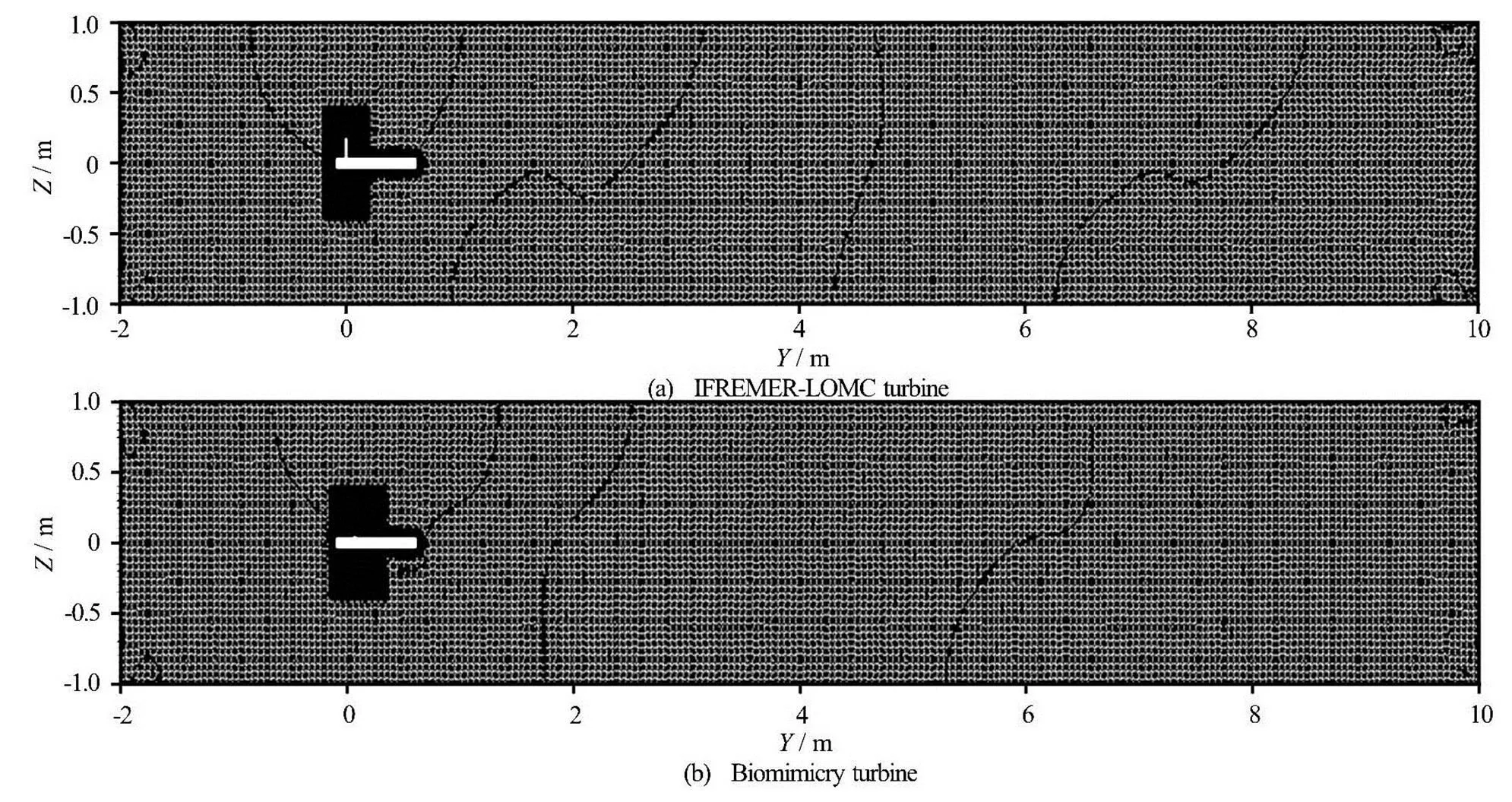
Fig.12 Slice sections of mesh domains showing the turbine, rotor and stator
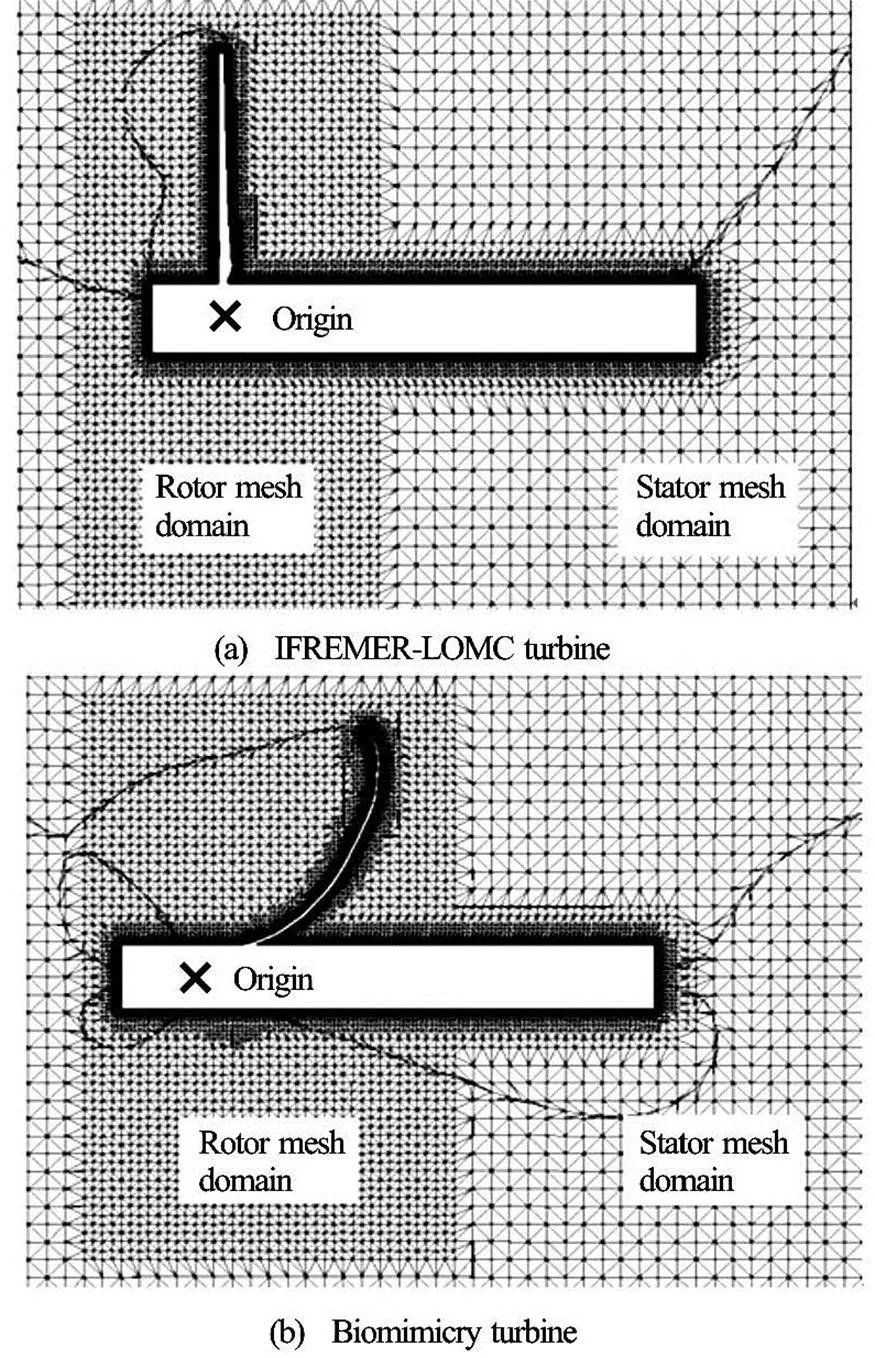
Fig.13 Enlarged view of the slice sections of mesh domain, sho- wing the origin for downstream distance measurements
Similar to grid independence test for hydrodyna- mic performance, the uncertainties for the grids were estimated using the factor of safety method. The un- certainty of the axial velocity at lateral distanceisof the 366 7938 mesh cells solution for IFREMER-LOMC turbine while it isof the 3 937 105 mesh cells solution for biomimicry turbine.
4. Results and discussion
For the case of hydrodynamic performance, dis- cussion is focused on the predicted hydrodynamic tor- que and thrust from the simulation results for the tur- bine of Ref.[4] and biomimicry marine current turbine. Comparisons on power coefficient,and thrust coe- fficient,for each simulated turbines were also pre- sented and discussed in this section. For the case of wake predictions, several aspects of the turbine wake properties of the IFREMER-LOMC turbine and the proposed biomimicry turbine were discussed in detail. The discussed aspects were the velocity distribution, vorticity, pressure distribution, wake recovery dista- nce and the particle streamlines from the predicted re- sults. Through the comparisons of the results from these aspects, the feasibility of the proposed biomimi- cry turbine to be adopted in turbine farm design can be predicted. Table 6 shows the summary of the con- ditions and predicted results for the wake simulation of the IFREMER-LOMC turbine and biomimicry tur- bine.

Table 6 Summary of conditions and predicted results of wake simulation for IFREMER-LOMC and biomimicry turbine
4.1
The hydrodynamic performance of the proposed biomimicry marine current turbine outweighs the tur- bine of Ref.[4] in terms of torque. Referred to Table 7, the hydrodynamic torque produced by the biomimicry turbine is greater than that of Ref.[4] fromto. The predicted maximum torque produ- ced by the proposed biomimicry marine current turbi- ne at zero rotational speed is 38.71 Nm which is 1 110% greater than the torque generated by the turbi- ne of Ref.[4]. The high torque generated by the biomi- micry turbine can overcome resisting torque (e.g. cau- sed by friction) from the nacelle effectively and thus avoids rotor jamming problems especially during ini- tial stage when the turbine starts to rotate. Table 7 shows the hydrodynamic torque comparison between turbine of Ref.[4] and biomimicry turbine.
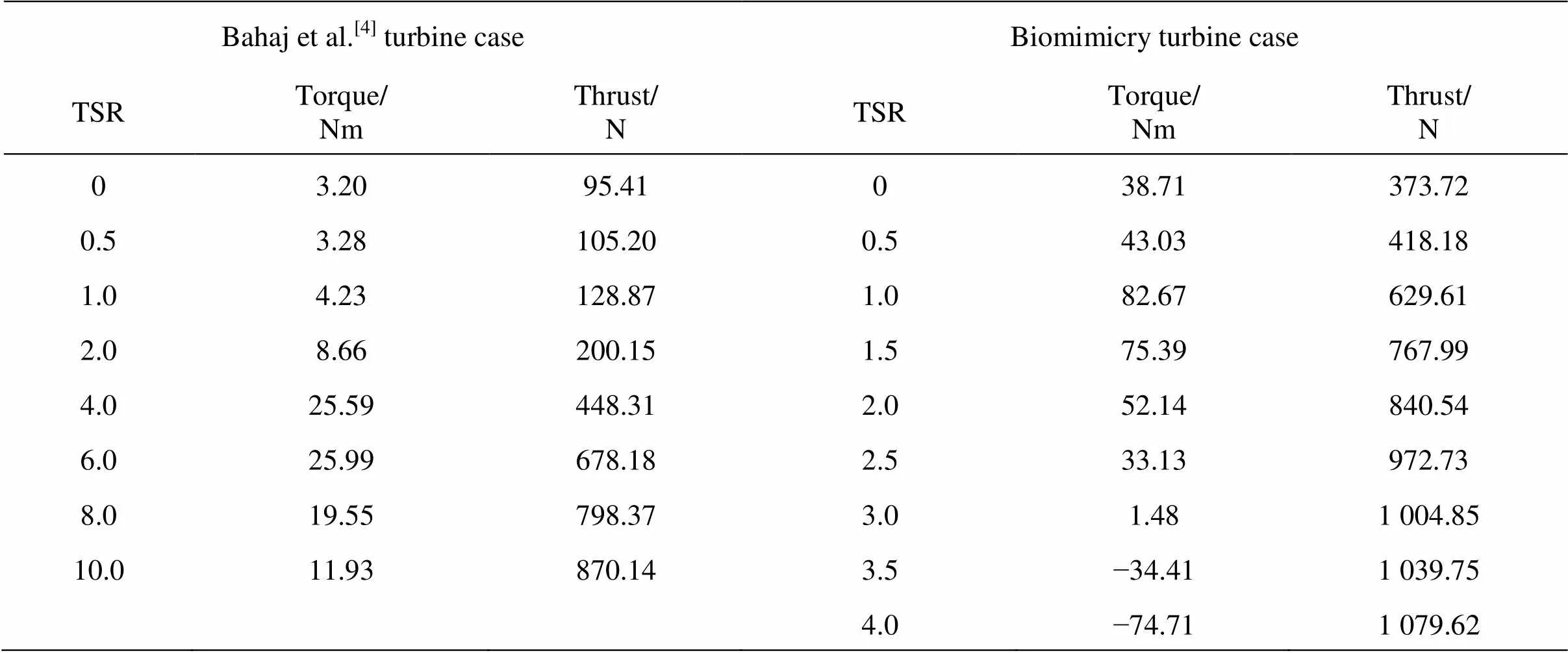
Table 7 Hydrodynamic torque comparison between the turbine of Ref.[4] and biomimicry turbine
The high thrust produced by the biomimicry tur- bine as shown in Table 7 is detrimental to the turbine blade root due to the induced bending moment. The required rigidity and elastic properties of the turbine blade will be determined by the thrust produced by the marine current turbine during its operation. Higher ge- nerated thrust will lead to more amount of or expensi- ve materials needed to strengthen the turbine blade root. However, the blade root bending moment might be able to be alleviated by introducing flexible turbine blade. Further study will be conducted in the future to investigate the efficiency of flexible turbine blade in relieving blade root bending moment. Despite the blade rigidity issue, the thrust produced by the biomi- micry turbine at optimum TSR,is only 13.24% greater than the thrust produced by the turbine of Ref.[4] at its optimum Tip Speed Ratio,. This extra 13.24% of thrust can be overcome by stre- ngthening the blade root with stronger material and proper reinforcement. The suitable blade thickness and materials to strengthen the biomimicry blade will also be investigated in future study.
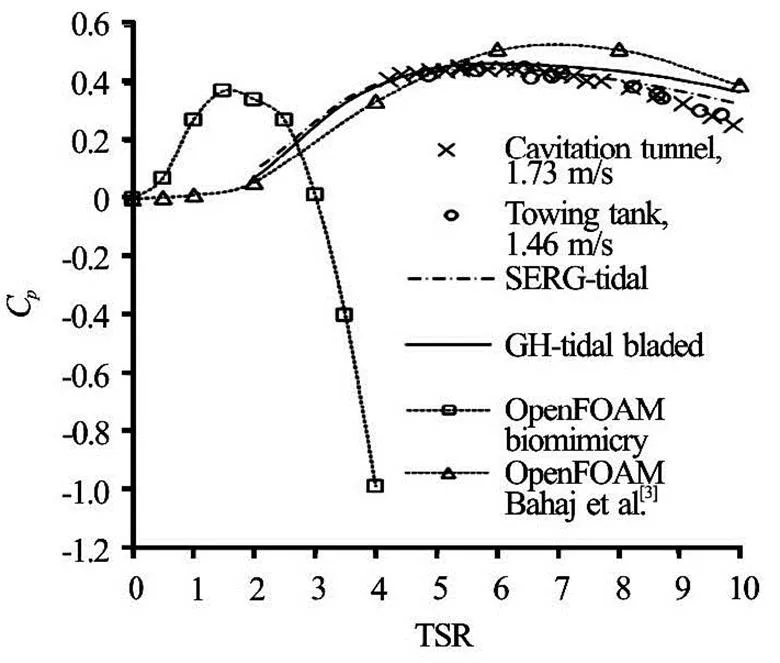
Fig.14 Power coefficient graph of the turbines resulted from ca- vitation tunnel, towing tank, SERG-Tidal, GH-Tidal Bladed and OpenFOAM simulations. The cavitation tu- nnel, towing tank, SERG-Tidal and GH-Tidal Bladed results were adopted from Ref.[4]
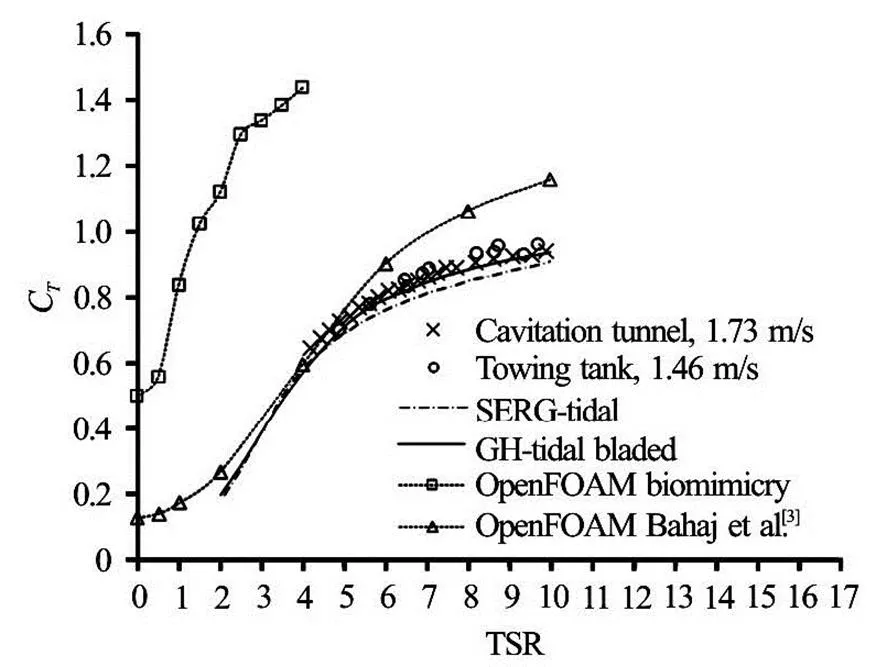
Fig.15 Thrust coefficient graph of the turbines resulted from cavitation tunnel, towing tank, SERG-Tidal, GH-Tidal Bladed and OpenFOAM simulations. The cavitation tu- nnel, towing tank, SERG-Tidal and GH-Tidal Bladed results were adopted from Ref.[4]
Similar to the hydrodynamic performance com- parisons with Ref.[4], the power coefficient,and thrust coefficient,of the biomimicry marine cu- rrent turbine were also compared to IFREMER- LOMC turbine from Ref.[11]. Referred to the OpenFOAM results, the optimum TSR for the biomi- micry marine current turbine is 1.5 and the maximum power coefficient,is approximately 0.38 while the optimum Tip Speed Ratio, TSR for the IFREMER- LOMC marine current turbine is 3.67 and the maxi- mum power coefficient,is approximately 0.37. These approximately the same maximum power coe- fficients (0.37 and 0.38) of the IFREMER-LOMC and biomimicry turbine will give valid wake properties comparisons as shown in the next sections. Figure 16 and Fig.17 show the predicted power coefficient and thrust coefficient graphs with the results adopted from Ref.[4].
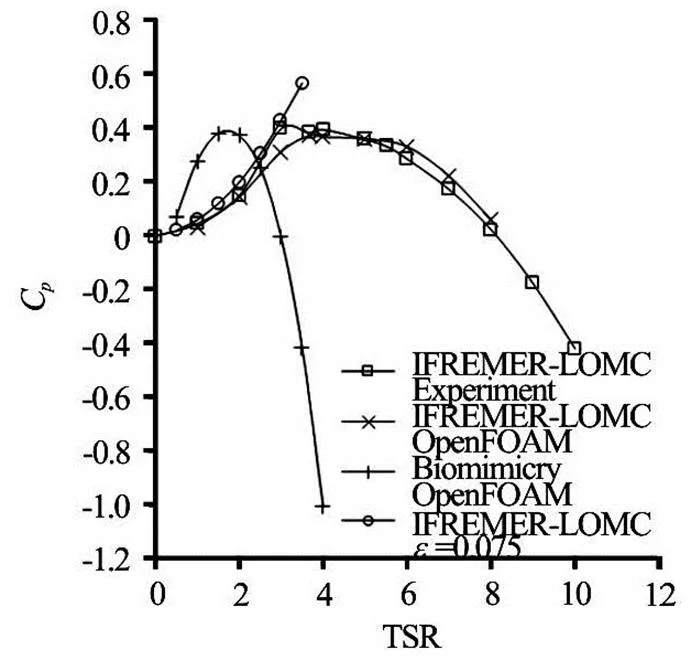
Fig.16 Power coefficient graph of the turbines resulted from experiment, particle method and OpenFOAM simulatio- ns. The IFREMER-LOMC experiment and particle me- thod results were adopted from Ref.[11]. represents smoothing parameter in particle method prediction by Ref.[11].
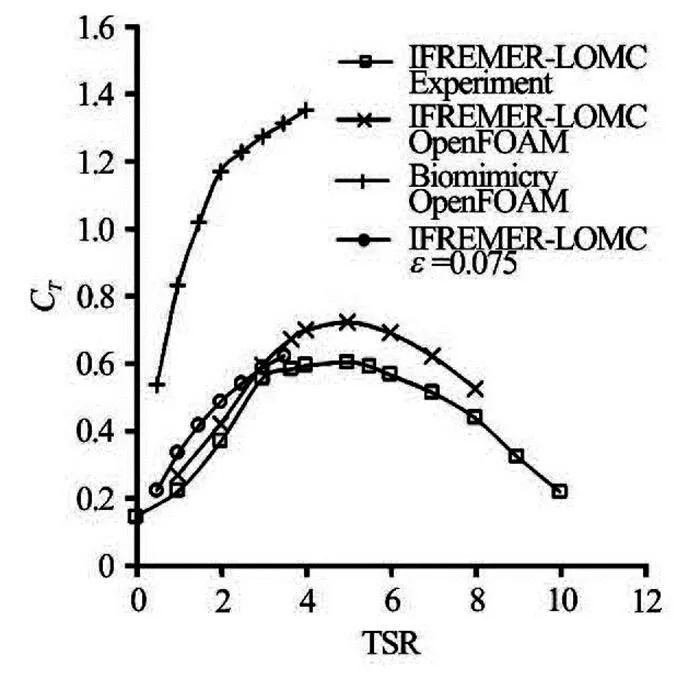
Fig.17 Thrust coefficient graph of the turbines resulted from experiment, particle method and OpenFOAM simulatio- ns. The IFREMER-LOMC experiment and particle me- thod results were adopted from Ref.[11]
The predicted power coefficient,of the bio- mimicry marine current turbine decrease abruptly once the TSR is larger than 2 which is much lower than the two conventional marine current turbines ac- cording to Fig.14 and Fig.16. The range of operative TSR (assuming preferable) for the biomimi- cry marine current turbine is limited from 1 to 2.5 while it is wider for the case of the other two conven- tional marine current turbines. This limited range of operative TSR will cause the necessity to control the rotational speed of the turbine based on incoming flow velocity in order to achieve optimum power extraction. The mentioned control also applies to the limited ope- rative TSR range for the biomimicry marine current turbine in terms of the thrust coefficient,accordi- ng to Fig.15 and Fig.17. Improvements on the design of this biomimicry marine current turbine with respect to the stated limitation will be discussed in future study.
Validation of the OpenFOAM predictedandwere done by referring to the experimental results from Ref.[4] and also Ref.[11]. The average compari- son error of the OpenFOAM predictedandwith Ref.[4] turbine isand(whereis percentage of experimental data) while it isandrespectively for the case of IFREMER-LOMC turbine. These large avera- ge comparison error may be due to the limitations of the implemented turbulence model or solver in predi- cting accurate hydrodynamic forces especially in high pressure gradient region e.g. blade surfaces and near wake region. The cause of this large average compari- son error will be studied in future by comparing the results from implementing different turbulence models and solvers to simulation of the turbine of Ref.[4] and IFREMER-LOMC marine current turbine e.g. other Low-Reynolds turbulence model with transient solver.
4.2
The axial velocity contour plots and velocity line plots of the wake of IFREMER-LOMC turbine and biomimicry turbine were discussed in this study. The axial velocity contour plots show no significant diffe- rence of the turbine wake pattern at the far wake re- gion while the degree of fluctuations of axial velocity is very much different at the near wake region. The near wake region is defined as the wake region within distances offrom origin while the far wake region is farther thanaway in the downstream direction according to Ref.[11]. Figure 18 shows the simulated velocity contour plots along the downstream direction for the IFREMER-LOMC turbine and biomimicry tur- bine.
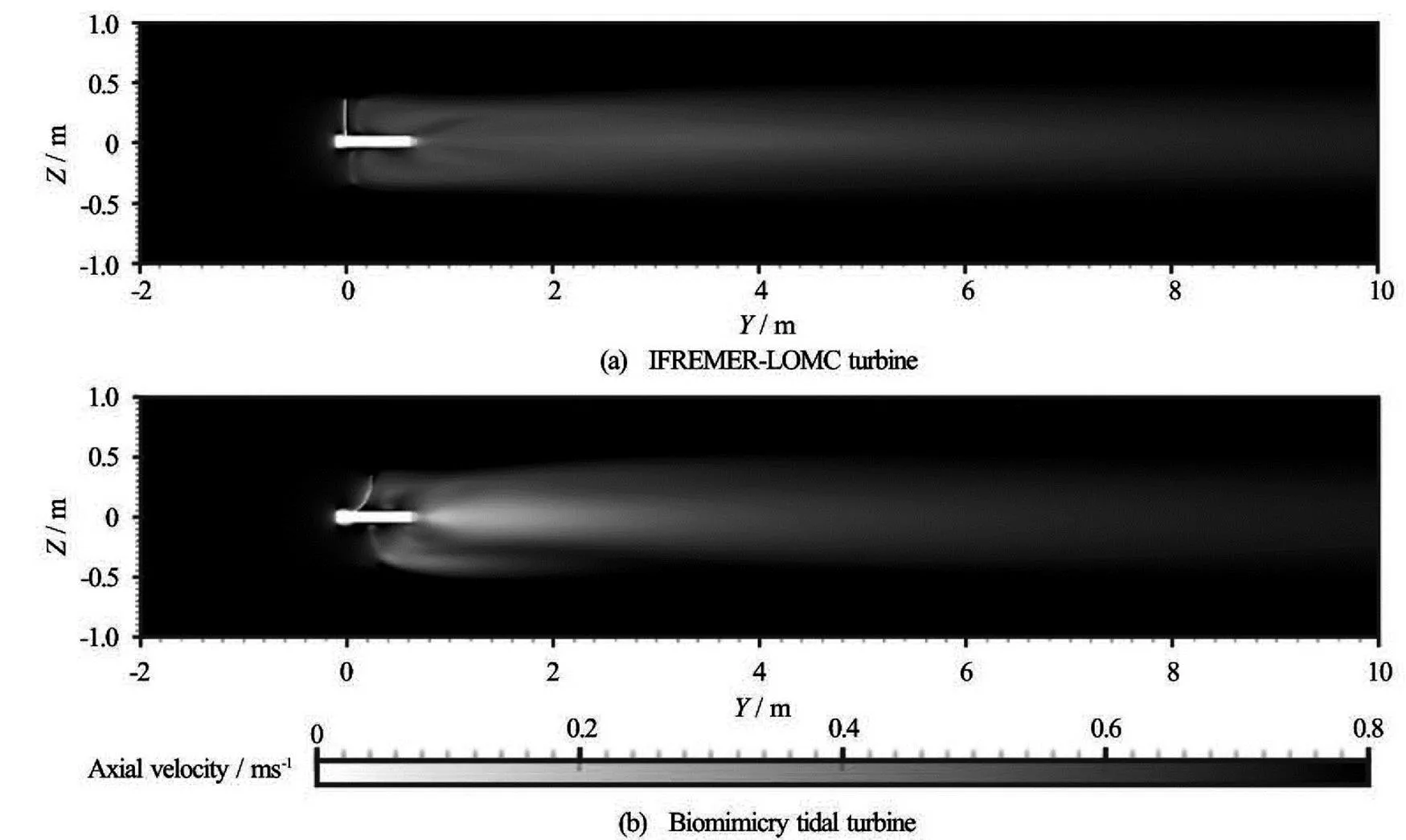
Fig.18 Velocity contour plots
To go in depth on the turbine wake properties, the velocity line plots are discussed. This discussion will focus on the difference of OpenFOAM results on turbine wake between the IFREMER-LOMC turbine and biomimicry turbine. The purpose of including the experimental and particle method results from Ref.[11] is to validate the results for IFREMER-LOMC turbine predicted by OpenFOAM. Since the velocity line plots of the IFREMER-LOMC turbine predicted by OpenFOAM lies within the ranges of the experimental and particle method results from Ref.[11] as shown in Figure 19 and Figure 20, the validation is considered done for this study. Figure 19 shows the near wake while Figure 20 shows the far wake of the axial velo- city distribution line plots for IFREMER-LOMC tur- bine and Biomimicry turbine.
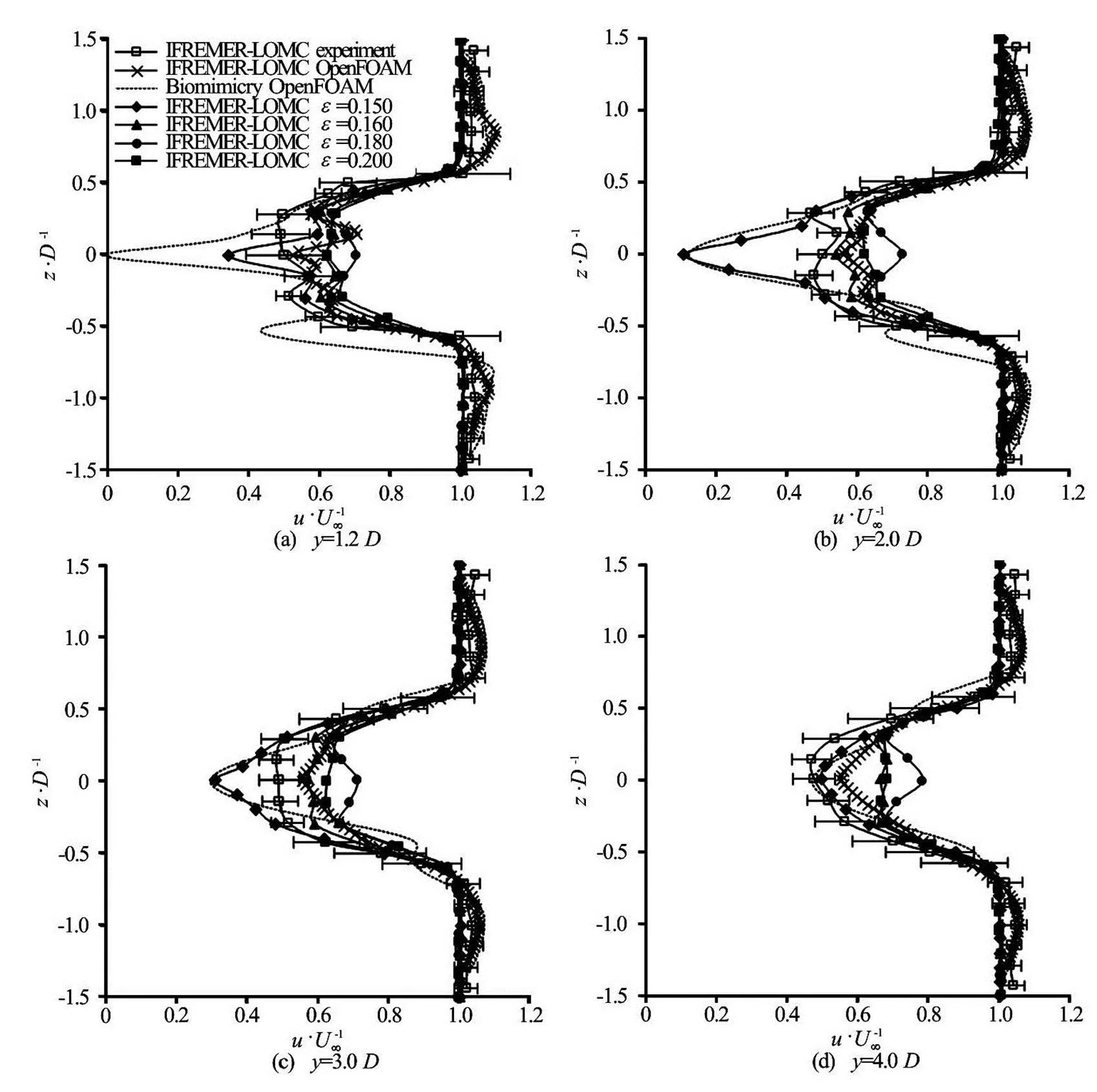
Fig.19 Velocity line plots showing axial velocity distribution at different locations in near wake at downstream direction for IFREMER-LOMC and Biomimicry turbine cases from this study and Ref.[11]. Note: The letter denotes measurement of distance in diameters of rotor, in this case is 0.7 m. e.g. means 1.2 times diameter of rotor measured from origin. The lateral bars for the experimental data represent the standard deviation around the mean velocity value
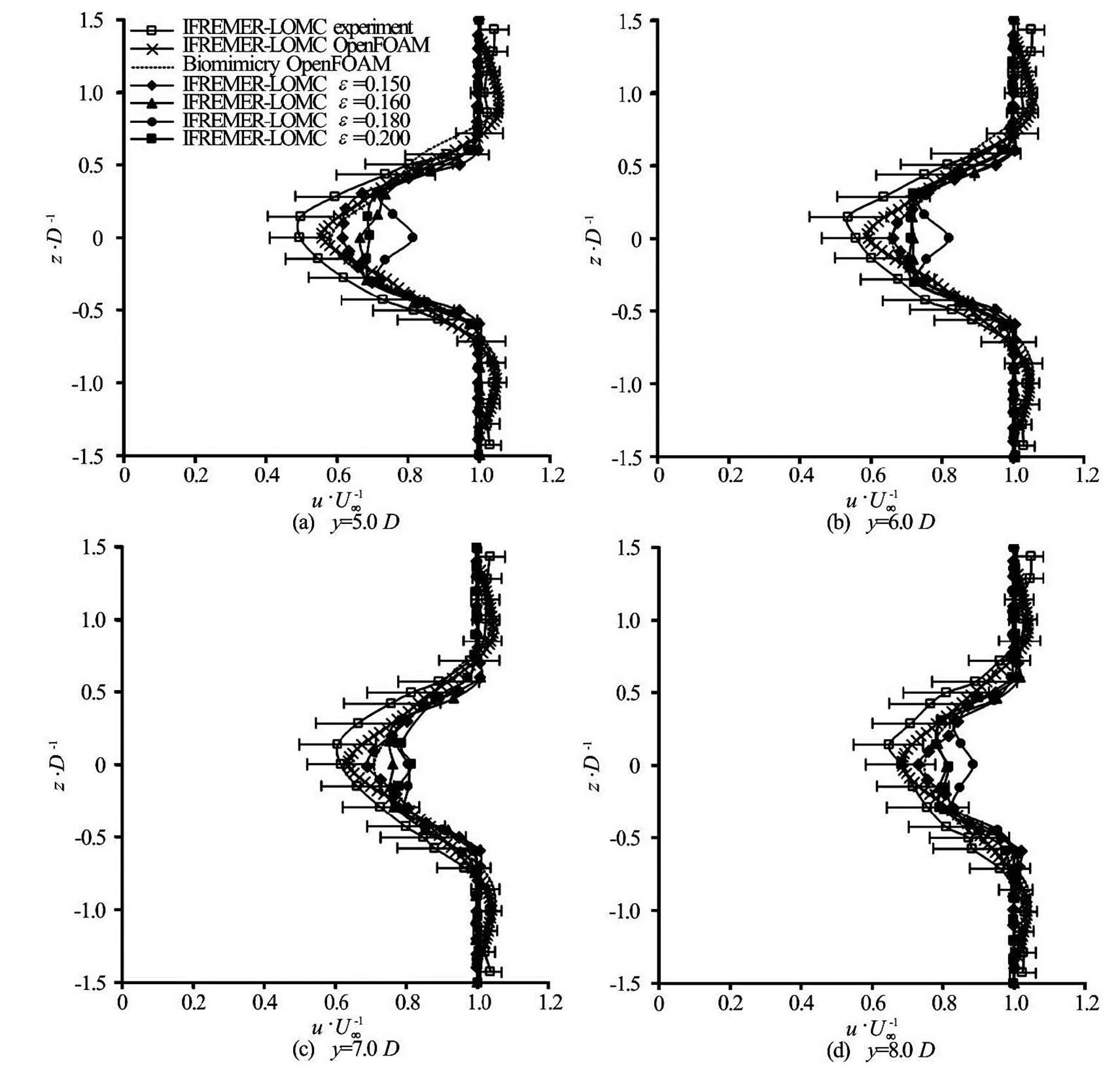
Fig.20 Velocity line plots showing axial velocity distribution at different locations in far wake for IFREMER-LOMC turbine and Biomimicry turbine from this study and Ref.[11]
For the case of near wake, the velocity distribu- tion of the biomimicry turbine wake predicted by OpenFOAM shows lower axial velocity values at the axis of rotation,compared to IFREMER- LOMC turbine. This low axial velocity suggests that the larger blade area of the biomimicry turbine captu- res more incoming flow near the hub region compared to IFREMER-LOMC turbine. This is different at far wake region where the axial velocity on the axis of rotation of the biomimicry turbine wake is higher compared to IFREMER-LOMC turbine. This might means that the wake recovery of the biomimicry turbi- ne wake is shorter than the IFREMER-LOMC turbine wake. The axial velocity distribution for the biomimi- cry turbine and IFREMER-LOMC turbine were of no much difference at the wake region outside the rotor area, forand. This suggests that the wake expansion for the biomimicry turbine wake is the same as the IFREMER-LOMC turbine wake throughout the downstream direction. This result also implies that the spacing of a biomimicry turbine farm in lateral can be the same as a turbine farm from IFREMER-LOMC turbines.
There are significant differences observed in the vorticity contour plots of the predicted wake of IFREMER-LOMC turbine and biomimicry turbine. More vortices formed in a turbine wake means more translational flow being converted to local rotational flow. If more translational flow is being converted to local rotational flow, then there will be less energy left for extraction in the downstream wake. For the case of IFREMER-LOMC turbine wake, the flow with high vorticity magnitude (Vorticity magnitude) is distri- buted further downstream compared to the biomimi- cry turbine wake. The high vorticity regions are distri- buted at the tip of the IFREMER-LOMC turbine and also behind its hub. The biomimicry turbine wake vor- ticity is observed to be concentrated nearer to the tur- bine. These differences further support that the biomi- micry turbine wake recovery distance is shorter com- pared to IFREMER-LOMC turbine wake. Figure 21 further illustrates the vorticity of the IFREMER- LOMC and biomimicry turbine.
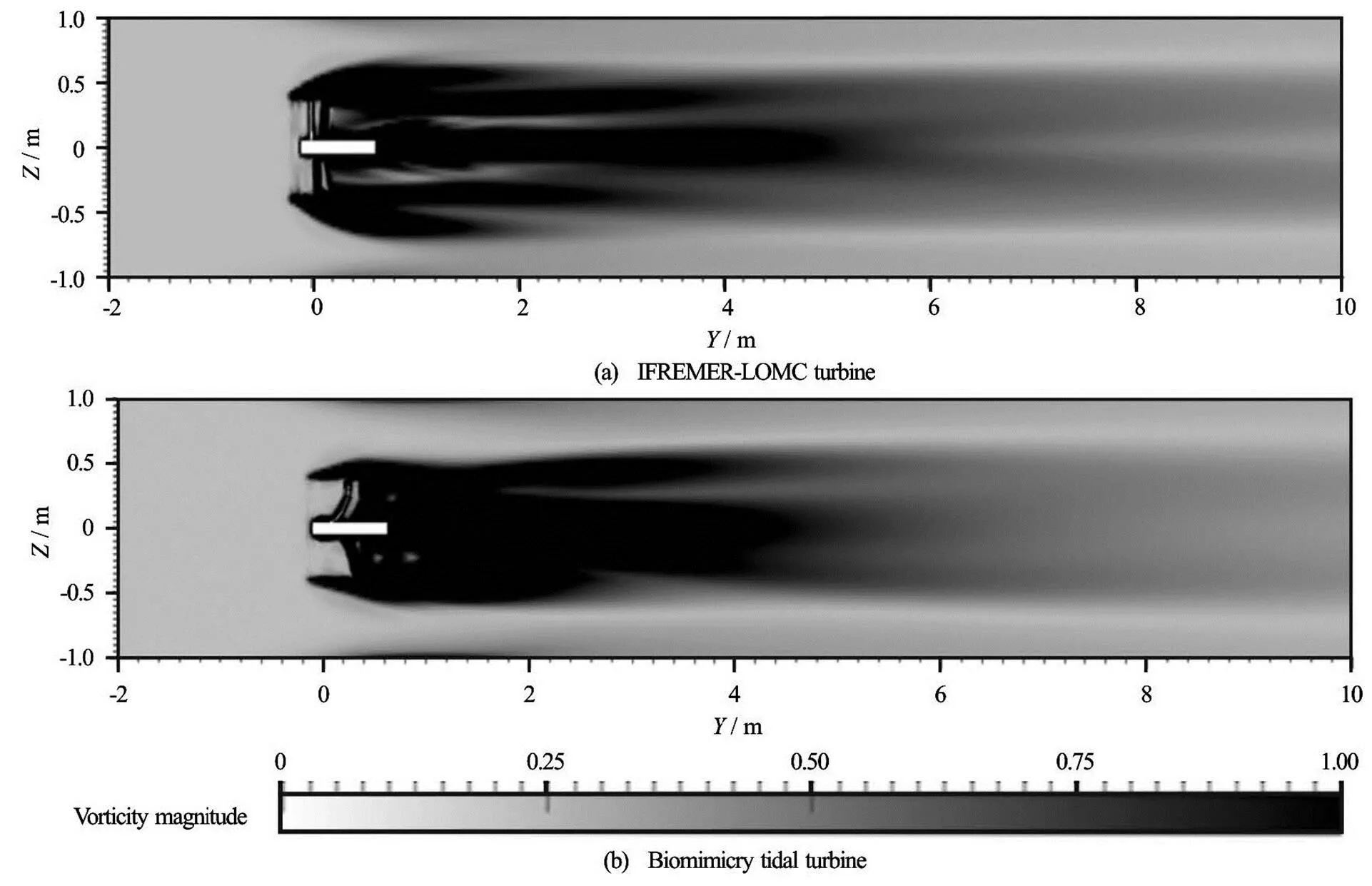
Fig.21 Vorticity contour plots of simulation
The wakes of IFREMER-LOMC turbine and bio- mimicry turbine show significant reduction of pressu- re at the axial region. This reduction of pre- ssure indicates that the flow is disturbed and slowed down by the rotating turbine. It is observed that the dip of the pressure distribution of the biomimicry tur- bine at the near wake is lower than the IFREMER- LOMC turbine (at,,and). The dip of the pressure distribution of the biomimicry turbine wake becomes higher than the dip of the pre- ssure distribution of the IFREMER-LOMC turbine wake further downstream from the location at. This observation also strengthens the idea that the wake recovery distance for the biomimicry turbine is shorter than the wake recovery distance of IFREMER-LOMC turbine wake. Figure 22 shows the pressure distribution plot of the IFREMER-LOMC and biomimicry turbine at near wake while Fig.23 shows the pressure distribution plot of the IFREMER- LOMC and biomimicry turbine at far wake.

Fig.22 Pressure distribution line plots at different locations in near wake in downstream direction for IFREMER- LOMC turbine and Biomimicry turbine simulated by OpenFOAM

Fig.23 Pressure distribution line plots at different locations in far wake in downstream direction for IFREMER- LOMC turbine and Biomimicry turbine simulated by OpenFOAM
Validation of the OpenFOAM predicted turbine wake axial velocity was done by referring to the expe- rimental results from Ref.[11]. The average compari- son error of the OpenFOAM predicted axial velocities with Ref.[11] turbine ranges fromtowith a decreasing magnitude oftowa- rds downstream direction.
4.3
The mean axial velocity deficits along the down- stream direction of the turbine wake were calculated by using the integrated axial velocity deficit equations from Ref.[11]. Equations (4)-(6) as shown below were the related equation used in obtaining the mean velo- city deficits.
Pinon et al.[11]took. This enlarged the integration interval to the two nearest ex- perimental measurement nodes outside the rotor. The whole velocity deficit was taken into account in this way including the velocity deficit of the biomimicry turbine wake. Figure 24 shows the mean axial velocity deficit graphs between wakes IFREMER-LOMC tur- bine and biomimicry turbine.
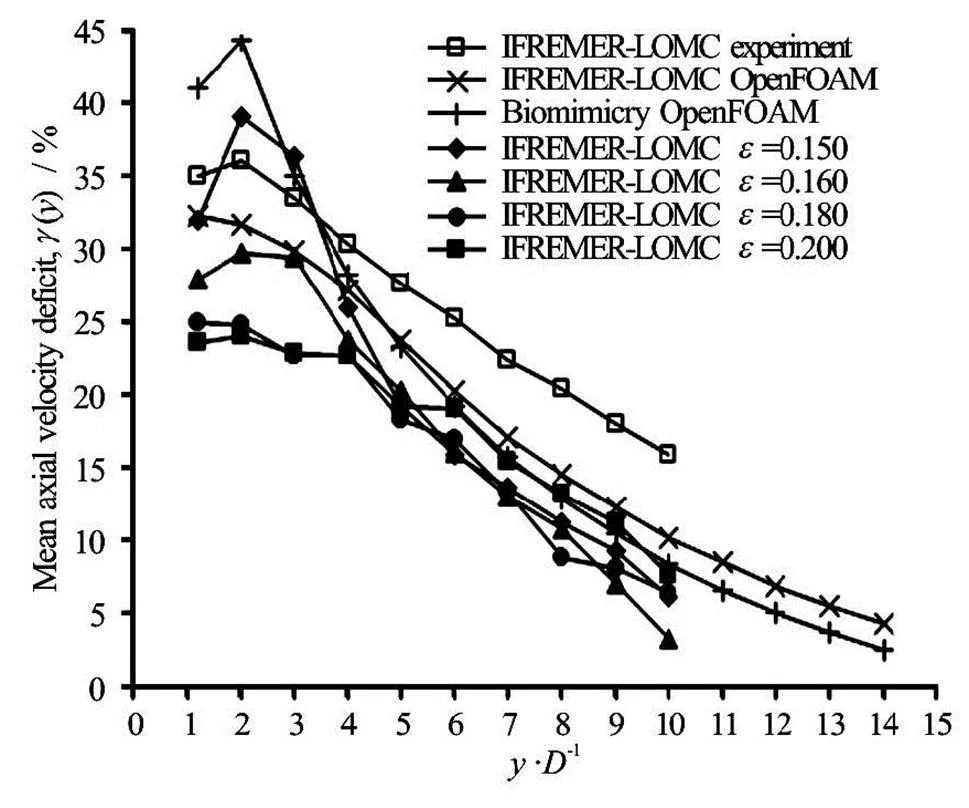
Fig.24 Mean axial velocity deficit against downstream distance graph for experimental and numerical results on the wake of IFREMER-LOMC turbine and biomimicry tidal turbine
The curves of the mean axial velocity deficit graph for the IFREMER-LOMC turbine and biomimi- cry turbine simulated by OpenFOAM were extended forward and their intercepts on the horizontal axis,show the predicted wake recovery distances. It was assumed that the mean axial velocity deficit cur- ves at further downstream to be represented by natural log equations. Thus, a logarithmic trend line is applied to the mean axial velocity deficit curves in MS Excel. The intercepts show the wake recovery distances for biomimicry turbine case is about(11.21 m) while it is about(12.54 m) for IFREMER- LOMC case. This made the wake recovery distance of the proposed biomimicry turbine 10.6% shorter than the case of IFREMER-LOMC turbine. This implies that the spacing of a biomimicry turbine farm in do- wnstream direction can be shorter than the spacing of a turbine farm from IFREMER-LOMC turbines. This reduction in turbine spacing by implementing the pro- posed biomimicry turbine will increase the performan- ce of a turbine farm as more turbines can be included in a specific area. Figure 25 shows the predicted wake recovery distance of IFREMER-LOMC turbine and biomimicry turbine simulated by OpenFOAM on an enlarged scale of the mean axial velocity deficit graph.
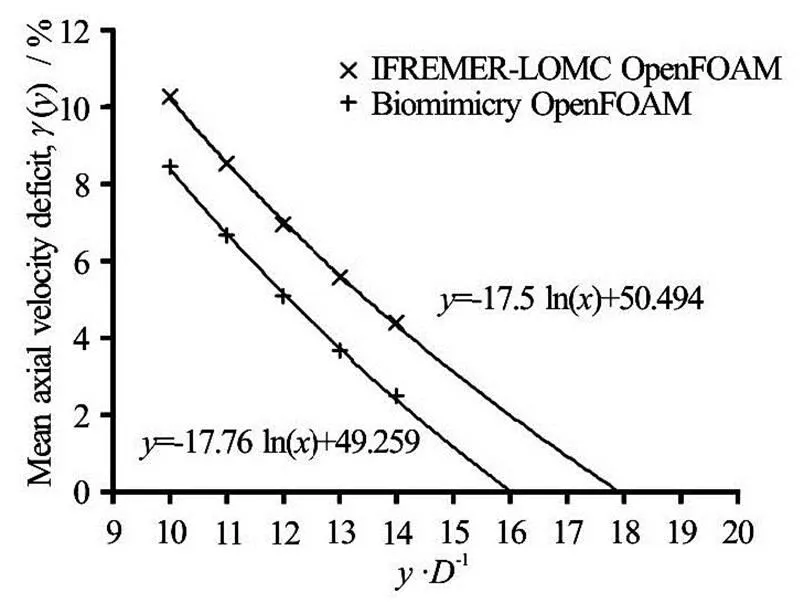
Fig.25 Predicted wake recovery distance of IFREMER-LOMC turbine and biomimicry turbine simulated by OpenFOAM on the mean axial velocity deficit against downstream distance graph. It is about (11.21 m) for biomimicry turbine while it is about (12.54 m) for IFREMER-LOMC turbine
Validation of the OpenFOAM predicted turbine wake mean axial velocity deficit was done by refe- rring to the experimental results from Ref.[11]. The average comparison error of the OpenFOAM predi- cted mean axial velocity deficit with Ref.[11] turbine is(whereis percentage of experime- ntal data).
4.4
The particle streamlines obtained from the simu- lation results further explain why the biomimicry tur- bine exhibits higher torque at zero or lower rotational speed. Swirling is clearly seen in the particle stream- lines behind the biomimicry turbine while it is less ob- vious for the turbine of Ref.[4]. The ability to deflect more incoming water particles into the direction tan- gentially to the rotational axis enables the biomimicry turbine to generate higher torque. The spoon like shape of the biomimicry turbine blade causes the rea- ction forces from the deflected water particles to be more concentrated near the blade tip. Thus, this blade property provides longer moment arm for higher tor- que generation. Figure 26 shows the particle stream- lines around the turbine of Ref.[4] and biomimicry turbine at zero rotational speed.
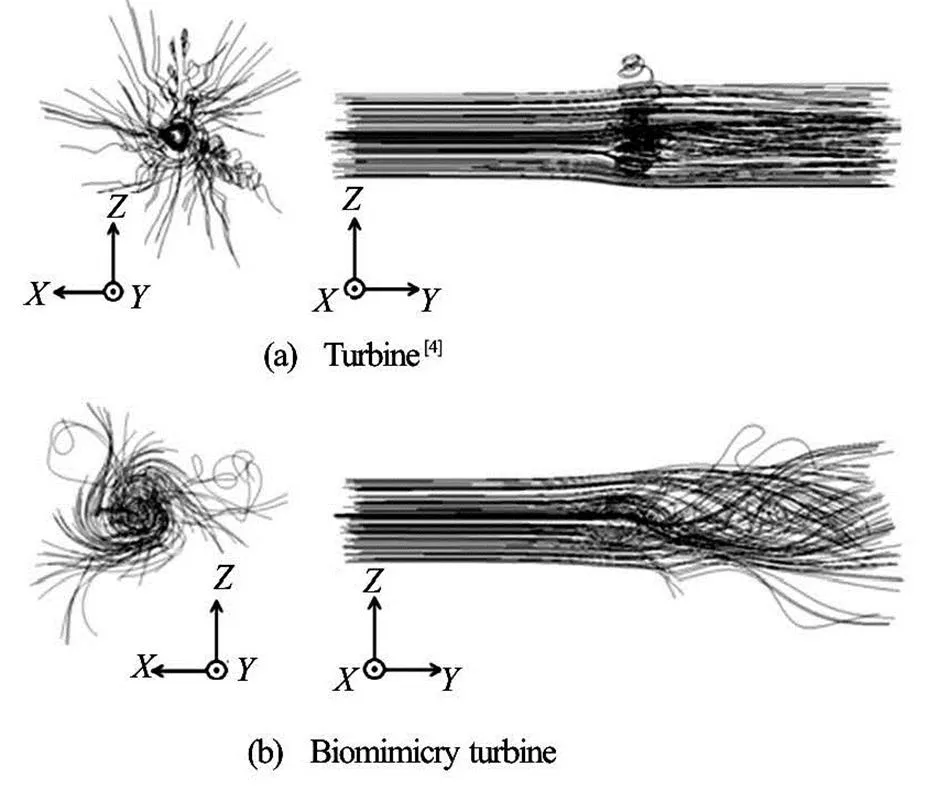
Fig.26 Particle streamlines at zero rotational speed (Note: Left side image shows back view while right side image shows side view of the mentioned particles streamlines)
On the other hand, the predicted particle stream- lines of the wakes of IFREMER-LOMC turbine and biomimicry turbine show similar characteristics which is helical. However, the pitch of the helical stream- lines in the near wake region was different for both cases. From the observations, the pitch of the predi- cted helical streamlines for the biomimicry turbine wake is shorter compared to IFREMER-LOMC turbi- ne wake. The water particles at the biomimicry turbine wake rotate more than the water particles at the IFREMER-LOMC turbine wake. This suggests that the biomimicry turbine is able to convert the transla- tional energy into rotational energy effectively despite the low operating rotational speed applied. Figure 27 shows the particle streamlines of the IFREMER- LOMC turbine and biomimicry turbine.

Fig.27 Particle streamlines
5. Conclusions
The preliminary results from the predictions by OpenFOAM showed the proposed biomimicry marine current turbine inspired by Dryobalanops aromatica seed have high potential to be implemented in the re- newable energy industry as an environmental friendly and effective energy extractor. The following are the research findings in this study:
(1) The hydrodynamic torque produced by the biomimicry turbine is greater than the turbine of Ref.[4] from at lower TSR which is fromto. This high torque generated by the bio- mimicry turbine overcome the resisting torque from the nacelle and thus avoids rotor jamming problems.
(2) The thrust produced by the biomimicry turbi- ne at optimum TSR,is 13.24% greater than the thrust produced by the turbine of Ref.[4] at optimum TSR,. This extra 13.24% of thru- st can be overcome by strengthening the blade root with stronger material and proper reinforcement.
(3) The power coefficients predicted in this study show that the biomimicry marine current turbine ope- rates at lower TSR. This low operating rotational speed makes the biomimicry marine current turbine environmental friendly as the collision risk is expected to be relatively low compared to other conventional marine current turbines.
(4) The near wake region of the biomimicry ma- rine current turbine showed significant reduction in axial velocity. This result may indicate the effective- ness in capturing incoming flow due to larger blade area of the proposed biomimicry turbine. The far wake region of the biomimicry marine current turbine sho- wed that the expansion of the wake is not much diffe- rent from the IFREMER-LOMC turbine wake. This result suggests that the spacing of the biomimicry tur- bine farm in lateral can be the same compared to a tur- bine farm from IFREMER-LOMC turbines.
(5) The predicted wake recovery distances is about(11.21 m) for biomimicry turbine case while it is about(12.54 m) for IFREMER- LOMC turbine. This made the wake recovery distance of the proposed biomimicry turbine 10.6% shorter than that of IFREMER-LOMC turbine. This short wake recovery distance suggests that the performance of a turbine farm will be improved by implementing the proposed biomimicry turbine as more turbines can be included in a specific area.
(6) The predicted water flow at the wakes of bio- mimicry turbine and IFREMER-LOMC turbine is he- lical. The shorter pitch of the helix water particle path- way at biomimicry turbine wake suggest that the bio- mimicry turbine is able to convert the translational energy into rotational energy effectively despite the low operating rotational speed applied.
Experiments will be conducted in future study to further validate the predicted results. Through these studies, it is hope that the proposal of this biomimicry marine current turbine will be able to bring advance- ment in marine current turbine industries.
Acknowledgements
The author wish to extend his gratitude to Uni- versity of Malaya for the facilities and services provi- ded in supporting this study and also the effort in pre- serving the Dryobalanops aromatica trees in the cam- pus.
References
[1] MCADAM R. A., HOULSBY G. T. and OLDFIELD M. L. G. Experimental measurements of the hydrodynamic per- formance and structural loading of the transverse horizo- ntal axis water turbine: Part 2[J]. Renewable Energy, 2013, 59(6): 141-149.
[2] MCADAM R. A., HOULSBY G. T. and OLDFIELD M. L. G. Experimental measurements of the hydrodynamic per- formance and structural loading of the transverse horizo- ntal axis water turbine: Part 3[J]. Renewable Energy, 2013, 59(6): 82-91.
[3] BAHAJ A. S., MOLLAND A. F. and CHAPLIN J. R. et al. Power and thrust measurements of marine current turbines under various hydrodynamic flow conditions in a cavita- tion tunnel and a towing tank, Renew[J]. Renewable Ene- rgy, 2007, 32(3): 407-426.
[4] BAHAJ A. S., BATTEN W. M. J. and MCCANN G. Ex- perimental verifications of numerical predictions for the hydrodynamic performance of horizontal axis marine cu- rrent turbines[J]. Renewable Energy, 2007, 32(15): 2479- 2490.
[5] MYERS L., BAHAJ A. S. Wake studies of a 1/30th scale horizontal axis marine current turbine[J]. Ocean Enginee- ring, 2007, 34(5-6): 758-762.
[6] MYCEK P., GAURIER B. and GERMAIN G. et al. Ex- perimental study of the turbulence intensity effects on ma- rine current turbines behaviour. Part I: One single turbi- ne[J]. Renewable Energy, 2014, 68(7): 729-746.
[7] MYCEK P., GAURIER B. and GERMAIN G. et al. Ex- perimental study of the turbulence intensity effects on ma- rine current turbines behaviour. Part II: Two interacting turbines[J]. Renewable Energy, 2014, 68(7): 876-892.
[8] MYCEK P., GAURIER B. and GERMAIN G. et al. Nu- merical and experimental study of the interaction between two marine current turbines[J]. International Journal of Marine Energy, 2013, 1: 70-83.
[9] TEDDS S. C., OWEN I. and POOLE R. J. Near-wake characteristics of a model horizontal axis tidal stream tur- bine[J]. Renewable Energy, 2014, 63(1): 222-235.
[10] MAGANGA F., GERMAIN G. and KING J. et al. Experi- mental characterisation of flow effects on marine current turbine behaviour and on its wake properties[J]. Iet Re- newable Power Generation, 2010, 4(6): 498-509.
[11] PINON G., MYCEK P. and GERMAIN G. et al. Numeri- cal simulation of the wake of marine current turbines with a particle method[J]. Renewable Energy, 2012, 46(5): 111-126.
[12] ZHAO Guang, YANG Ran-sheng and LIU Yan et al. Hy- drodynamic performance of a vertical-axis tidal-current turbine with different preset angles of attack[J]. Journal of Hydrodynamics, 2013, 25(2): 280-287.
[13] WANG Ji-feng, PIECHMA Janusz and MÜLLER Norbert A novel design of composite water turbine using CFD[J]. Journal of Hydrodynamics, 2012, 24(1): 11-16.
[14] MAGANGA F., PINON G. and GERMAIN G. et al. Nu- merical simulation of the wake of marine current turbines with a particle method (congress)[J]. World Renewable Energy Congress X 2008. Glasgow, UK, 2008.
[15] KANG S., BORAZJANI I. and COLBY J. A. et al. Nume- rical simulation of 3D flow past a real-life marine hydro- kinetic turbine[J]. Advances in Water Resources, 2012, 39: 33-43.
[16] OBERKAMPF W. L., ROY C. J. Verification and vali- dation in scientific computing[M]. New York, USA: Cambridge University Press, 2010.
[17] ROACHE P. J. Verification of codes and calculations[J]. AIAA Journal, 1998, 36(5): 696-702.
[18] XING T., STERN F. Closure to “Discussion of ‘Factors of safety for Richardson extrapolation’ˮ[J]. Journal of Fluids Engineering, 2011, 133(11): 115501.
[19] XING T., STERN F. Factors of safety for Richardson ex- trapolation[J]. Journal of Fluids Engineering, 2010, 132(6): 061403.
* Biography: Yung-Jeh CHU (1987-), Male, Graduate Civil Engineer
10.1016/S1001-6058(16)60614-5 2016,28(1):125-141
杂志排行
水动力学研究与进展 B辑的其它文章
- Flow, thermal criticality and transition of a reactive third-grade fluid in a pipe with Reynoldsʼ model viscosity*
- Investigation of the effects of platform motion on the aerodynamics of a floating offshore wind turbine*
- Mixing of two different electrolyte solutions in electromagnetic rectangular mixers*
- Study of bedload transport in backwater flow*
- Experimental study of water and dissolved pollutant runoffs on impervious surfaces*
- A numerical model for pipelaying on nonlinear soil stiffness seabed*